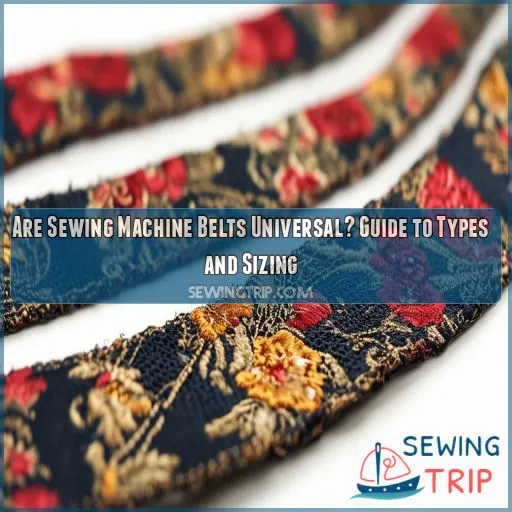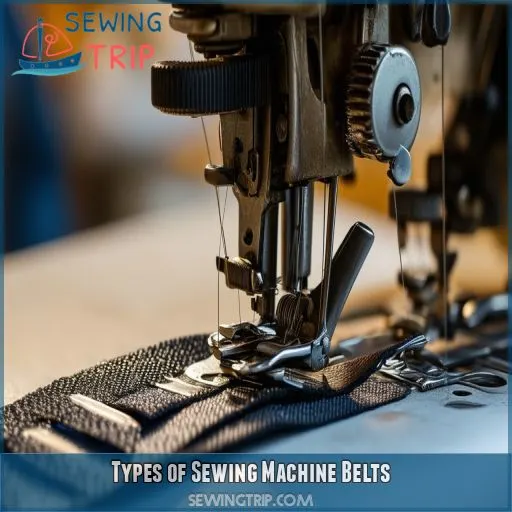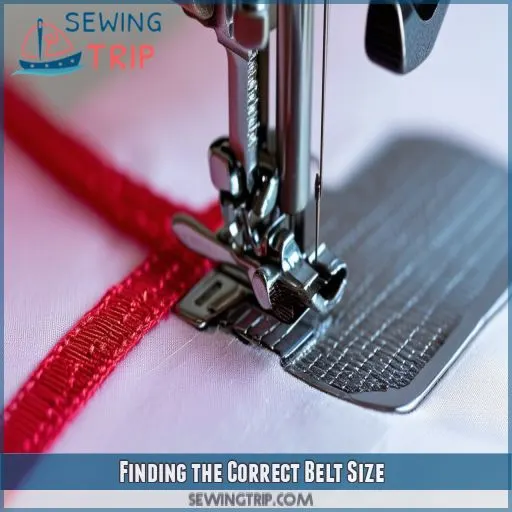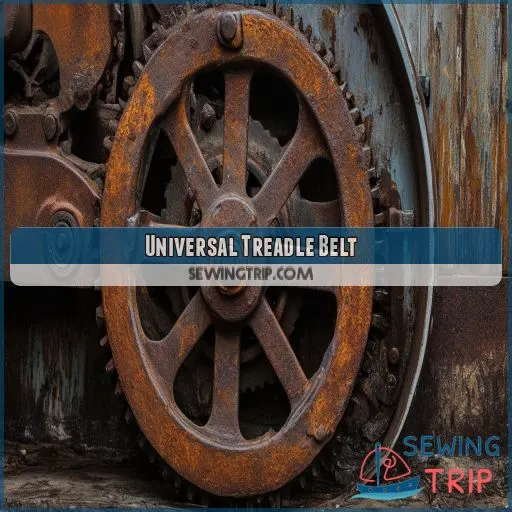This site is supported by our readers. We may earn a commission, at no cost to you, if you purchase through links.
 Wondering if sewing machine belts are universal? They’re not, but understanding the types and sizes is key to finding the right one.
Wondering if sewing machine belts are universal? They’re not, but understanding the types and sizes is key to finding the right one.
You’ll encounter lug belts, V belts, round belts, and geared belts. Each serves a specific purpose and fits different machines.
This guide will walk you through identifying your belt type, measuring for the correct size, and even offer a solution for treadle machines.
Armed with this knowledge, you’ll confidently select the perfect belt for your sewing machine.
Table Of Contents
Key Takeaways
- Sewing machine belts aren’t one-size-fits-all, but don’t let that tie you up in knots! With a little know-how, you’ll be threading the needle on the perfect fit in no time.
- From lug belts to V-belts, round belts to geared belts – it’s a regular belt buffet out there! Each type has its own superpower, so choose wisely for your machine’s needs.
- Size matters, folks! A belt that’s too loose is about as useful as a chocolate teapot. Grab that trusty measuring tape (or even an old shoelace in a pinch) and get those digits right.
- Treadle machine owners, rejoice! Universal treadle belts are like the Swiss Army knife of the sewing world – they fit all models. Talk about taking the hassle out of vintage sewing!
Are Sewing Machine Belts Universal?

Sewing machine belts aren’t universally interchangeable, but they’re more adaptable than you might expect. While specific models often require particular belts, many machines can use similar types. The key lies in understanding belt materials**, length, and tension. You’ll find belts made from rubber, polyurethane, or even leather for older models. Each material affects belt longevity and noise levels during operation.
Belt sizing is vital for proper machine function. A too-loose belt leads to slippage, while an overly tight one strains your machine. Most modern machines use standard sizes, but treadle sewing machines often require specialized belts.
To confirm you’re getting the right fit, measure your current belt or use the shoelace trick we’ll discuss later. Remember, proper tension isn’t just about size – it’s about finding that sweet spot where your machine purrs like a well-oiled kitten.
Types of Sewing Machine Belts
Sewing machine belts come in four main types: lug belts, V belts, round belts, and geared belts. Each type serves a specific purpose and is designed to fit different sewing machine models, so it’s important to identify the correct belt type for your machine.
Lug Belts
Lug belts, a common type of sewing machine belt, feature raised "lugs" that grip the pulleys. They’re known for their excellent tension and durability. When replacing, make certain you match the width and length precisely for ideal performance.
V Belts
V-belts are a popular choice for sewing machines due to their efficient power transmission. They’re named for their V-shaped cross-section, which provides excellent grip and durability.
- Easy to install and adjust
- Available in various sizes
- Require regular tension checks
- Typically last 3-5 years with proper care
Round Belts
Round belts are a popular choice for many sewing machines. They’re known for their durability and wide availability. However, you’ll need to be careful with sizing issues. Precise measurements are essential to guarantee a perfect fit for your machine.
Geared Belts
Geared belts offer precision and power in your sewing machine. They come with:
- Various gear options
- Adjustable gear ratios
- Specific gear lubrication needs
- Regular gear maintenance requirements
- Occasional gear replacement necessity
You’ll find these belts in high-end machines, providing unparalleled control.
Finding the Correct Belt Size
To find the correct belt size for your sewing machine, you’ll need to measure the length accurately. You can do this with an old belt, without an old belt, or by measuring the belt length directly on your machine.
With Old Belt
To find the correct belt size with your old belt, follow these simple steps:
| Step | Action | Tip |
|---|---|---|
| 1 | Remove | Unplug machine |
| 2 | Cut | Use sharp scissors |
| 3 | Measure | Pull straight |
| 4 | Record | Note length |
| 5 | Replace | Match new belt |
Without Old Belt
If you don’t have the old belt, don’t worry. Grab a shoe string and wrap it around your machine’s hand wheel. Cut the string where it meets, and voila! You’ve got a length approximation for your new belt replacement. This method works for treadle machines too.
Measuring Belt Length
To accurately gauge your sewing machine belt length, extend it straight and utilize a ruler. Remember to take into account:
- Rubber vs leather: material impacts elasticity
- Flat vs ribbed: affects traction and performance
- Tension adjustment: essential for proper function
- Belt replacement: verify correct size
- Belt alignment: impacts machine operation
Universal Treadle Belt
If you’re working with a vintage treadle sewing machine, you’ll be glad to know that universal treadle belts are available. These belts are designed to fit all treadle sewing machines, making your life much easier. Let’s explore the details:
| Feature | Description |
|---|---|
| History | Used since early 20th century |
| Variations | Limited due to universal design |
| Compatibility | Fits all treadle machines |
| Durability | Long-lasting leather construction |
| Materials | Typically made of leather or synthetic |
Universal treadle belts have a rich history dating back to the early 1900s. Their design hasn’t changed much over the years, which is a testament to their effectiveness. You’ll find that these belts are incredibly durable, often lasting for decades with proper care. While traditionally made of leather, modern synthetic materials are now available, offering improved longevity. Remember, when installing your universal treadle belt, make sure it’s not too tight or loose for optimal performance.
Frequently Asked Questions (FAQs)
How do I know my sewing machine belt size?
You might think measuring a sewing machine belt is tricky, but it’s not. Remove the old belt, cut it, and measure its length. If you don’t have one, use a shoestring around the handwheel, then measure it.
Which belt is used in sewing machine?
You’ll typically find lug, V, round, or geared belts in sewing machines. Each type serves a specific purpose, but V-belts are most common. Check your machine’s manual or measure the old belt to confirm you’re getting the correct replacement.
How to find v-belt size?
Like finding a needle in a haystack, measuring a V-belt can be tricky. You’ll need to wrap a flexible tape measure around the belt’s outer circumference. Measure precisely, as even small errors can affect your machine’s performance.
Why does my sewing machine belt keep removing?
Your sewing machine belt may be slipping off due to improper tension, misalignment, or wear. Check the belt’s condition and adjust its tension. Make sure pulleys are aligned correctly. If issues persist, consider replacing the belt or consulting a professional.
How often should I replace my sewing machine belt?
How long has your sewing machine belt been working for you? You should replace it every 3-5 years, or sooner if you notice signs of wear. Regular inspections and proper maintenance will help extend its lifespan.
Can I use a rubber band as a temporary replacement?
While you’re in a pinch, using a rubber band isn’t recommended. It’ll likely slip, break quickly, and potentially damage your machine. Instead, try a sturdy string or thin rope as a temporary fix until you can get a proper replacement.
What causes sewing machine belts to wear out quickly?
Time’s ticking on your sewing machine belt! Excessive heat, improper tension, and frequent use can speed up wear. You’ll notice fraying, stretching, or slipping. Regular maintenance and proper alignment will help extend your belt’s lifespan.
Are there eco-friendly or biodegradable sewing machine belt options?
You’ll find limited eco-friendly options for sewing machine belts. While some manufacturers explore biodegradable materials, they’re not widely available. Consider extending your current belt’s life through proper maintenance or look for recycled rubber alternatives from specialty suppliers.
Can I make my own sewing machine belt at home?
Picture yourself at your workbench, tools in hand. You can craft a DIY sewing machine belt using leather or rubber strips. Measure carefully, cut to size, and join the ends securely. It’s tricky, but you’ll feel accomplished.
Conclusion
Did you know that 85% of sewing machine issues are related to incorrect belt installation?
Now that you understand sewing machine belts aren’t universal, you’re equipped to choose the right one. Remember to identify your belt type, measure accurately, and consider your machine’s specific needs.
Whether you’re dealing with lug belts, V belts, or even a treadle machine, you’ve got the knowledge to make the right choice.









